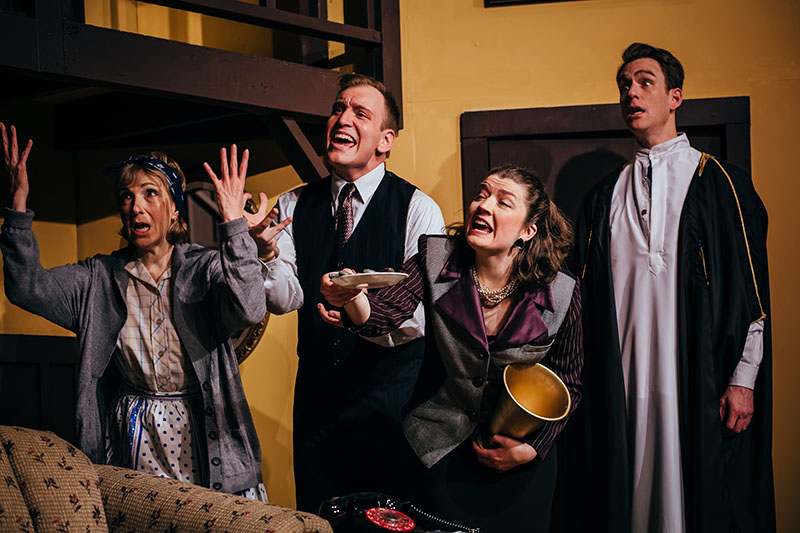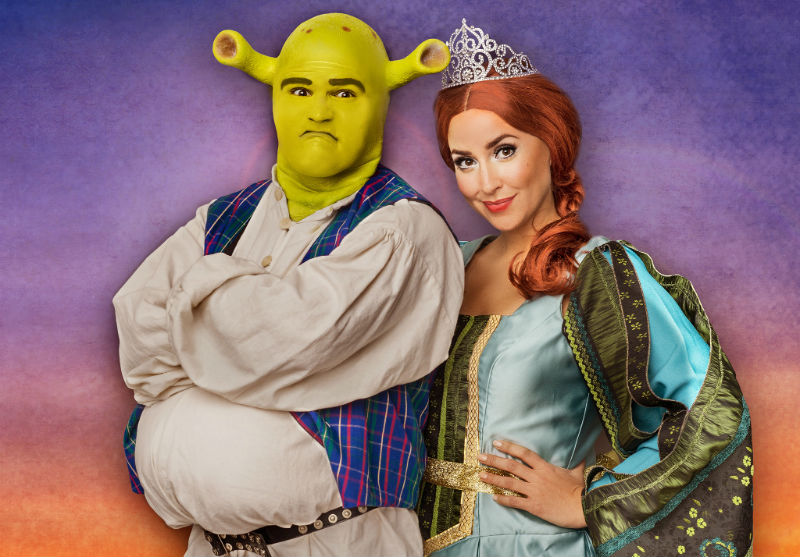Outer Devotion: “Protecting Wisdom: Tibetan Book Covers” at UMMA

First times are always special. But a first-ever of something is especially special. Such is the case with the University of Michigan Museum of Art’s exhibit Protecting Wisdom: Tibetan Book Covers From the Maclean Collection.
Mounted in the UMMA’s Irving Stenn Jr. Family Gallery, this display not only presents us with an incomparable iconographic delight, it’s also the first time this art form's been exhibited in the United States -- and one of the first times these artworks have been seen by the public. So, yes, Protecting Wisdom really is special.
As the guest curator, Dr. Kathryn Selig Brown (U-M Ph.D. in Tibetan History of Art), tells us in her introduction:
Review: Encore’s “Noises Off!” delivers a hilarious back-stage romp

The Encore Musical Theatre Company is taking a break from musicals to offer up a double dose of farce.
Slamming doors, fractured romances, comical confrontations, and lots of sardines happen on stage and off in Michael Frayn’s witty send-up of the theatrical life Noises Off! and the Encore company deliver a laugh-filled romp.
A very British theater group is traveling the countryside with a country house farce called Nothing On. Frayn’s play begins with a dress rehearsal that suggests the troupe is not quite ready for prime time and then takes us to two performances that devolve into chaos, one from the backstage view and the other from the stage view. It’s an affectionate but also biting view of theater types -- just the sort of thing theater types love to do.
Director Tobin Hissong keeps the verbal and physical action moving at breakneck speed. This is a play with a lot of witty dialogue and slapstick and mime. Hissong has a fine cast and he gets exactly the right comic effect from the various stereotypes Frayn uses for the play within the play and his portrayal of actors.
Daniel A. Helmer is the suave, sardonic Lloyd Dallas, the poor man assigned to direct Nothing On, a naughty sex farce. Helmer affects a just right Cary Grant snap in his English accent and a slightly florid set of gestures. At the beginning of the play, he’s a disembodied voice patiently and then less patiently taking his cast through their paces. Helmer has a winning charm that makes his character’s complicated romantic life believable and funny.
Bicentennial Smorgasbord: U-M Department of Dance's "Glancing Back, Dancing Forward"
Catching the University of Michigan’s bicentennial spirit, the Department of Dance’s student concert, Glancing Back, Dancing Forward (at the Power Center through Sunday), celebrates the Department’s own history and breadth.
A lobby installation -- designed by Stephanie Brown, Elizabeth Benedict, and Jessica Fogel -- chronicles the early days of dance at the U. There are pleasingly nostalgic photos of clogging and “aesthetic dances” in gossamer dresses out on the lawn, and excerpts from an early phys ed manual featuring line drawings and directions for calisthenics. Come the 1930s and '40s, we see the shift to “modern dance” in photos of earnest young women in Martha Graham-influenced dark jersey skirts.
Before the performance in the theater begins, the lobby is filled with dancers bringing these images to life. Choreographed by Department Chair Fogel and local tapper Susan Filipiak, this pre-show presents its examples of early-20th-century dance in overlapping layers. This results in sometimes odd but historically accurate juxtapositions, such as smiling, overalled tappers beside a stern woman in a high-necked ruffled blouse with a whistle.
Forgive & Reclaim: Tanner Porter's raw art-pop songs reach deep into the soul

As a member of the Celtic/Quebecois/American folk-meets-classical quartet Ensoleil, cellist Tanner Porter takes old songs and makes them contemporary through creative arrangements.
But as a solo artist, Porter plays her own compositions, which are thoroughly contemporary because of the creative arrangments.
The U-M grad composes the songs and arrangements with notation software, so even though her classically steeped art-pop sounds loose and jammed with details, it doesn't happen through randomness. The woozy blend of strings, piano, wind chimes, marimba, vibraphone, harp, woodwinds, and more are carefully plotted out with specific players in mind.
Porter's first album, 2012's The Child Wrote a Poem, is written like a 15-chapter book set to music. Her latest, 2016's The Summer Sinks, is a song cycle about hurt and redemption, and the music is even more fragmented and quirky than the sounds on her debut. But Porter's flexible voice, which can sound as delicate as a bird outside your window or as ferocious as a crow cawing on your shoulder, shapes the songs through elastic Joni Mitchell-like melodies and her smart, raw lyrics keep your ears attuned to the tune.
With a bachelor in music composition and a minor in creative writing, Porter combines the two disciplines with excellent results. But she's also a visual artist, hand drawing her brand new video, "II," the second promo clip in support of The Summer Sinks.
Now splitting time between her native California and Ann Arbor, Porter talked to us about her solo work, compositional process, the "II" video, and what's on tap for Ensoleil.
Fabulous Fiction Firsts: #624, #625, #626 & #627

Fabulous Fiction Firsts #627
“There are only two worlds - your world, which is the real world, and other worlds, the fantasy... these worlds provide an alternative." ~ Neil Gaiman
Set in an alternate modern-day England, Gilded Cage * by (Dr.) Vic(toria) James is first in the Dark Gifts dystopian trilogy. It is one of the LibraryReads February picks, "where enticing drama and social unrest mix with aristocratic scandal and glamorous magic." (Kirkus Reviews)
Thanks to clever Abi(gail), the Hadleys believe they have a better deal than most, as they have arranged to serve their decade of servitude (being commoners without the magical power of the aristocratic rulers) together. They will work as slaves at Kyneston, the country estate of the Jardines, one of the most powerful families in the country.
At the last minute, 16-year-old Luke Hadley is separated from the family and sent to Millmoor, Manchester’s infamous slave town to toil in its horrific factories where he finds friendship among those with a dangerous agenda. Meanwhile, Abi, yearning for love and knowledge, stumbles into the middle of Jardine family intrigues and political scheming that could alter their world forever.
From the "Neighborhood": A2 Native Ben Cowan's Art Installed at Westgate
The Ann Arbor District Library's Westgate branch is filled with new things. After all, it just reopened in September 2016 after a massive expansion and remodel.
But even newer than the computers, coffee shop, and shiny shiny bathrooms are three large paintings by Ann Arbor native Ben Cowan. The video above gives you a guided tour of Cowan's paintings. We also interviewed the artist about growing up in Ann Arbor, his influences, and how he came to create the works from his Neighborhood Views series, which have ended up finding permanent homes in the library.
Ignite the Dance: FUSE teaches everybody how to boogie

They say you should dance like no one is watching. But sometimes it's helpful to be aware of your audience -- especially if they're master dance instructors.
Mark Carpenter of Mountain View, California, and Barry Douglas of Detroit will be in Ann Arbor from February 3-5 as part of FUSE, teaching dance classes for beginners and experts alike. Put on by Ann Arbor Community of Traditional Music and Dance (AACTMAD) and A2 Fusion, the FUSE weekend includes instruction in fusion, blues, West Coast swing, and hustle as well as plenty of dance parties to test out your moves.
The AACTMAD page describes fusion as an “improvised lead-follow approach to dancing to any style of music that does not have a strictly defined dance aesthetic.” It incorporates a variety of styles to connect your movements with your partner’s movements and can either combine established dance styles or create an entirely unique dance experience.
“My version of fusion is a combination of dance styles and techniques," Carpenter said, "more than it is a dance in its own right, as in a basic step and mode of connection.”
Animating Theater: The Burns Park Players wrestle with "Shrek"

Directing the Burns Park Players’ annual stage musical, particularly for the first time, comes with unique challenges.
“Sometimes an actor goes, ‘I’m on call for heart surgery. I may have to leave because of that,’” said Matt Kunkel, who’s at the helm of BPP’s upcoming production of Shrek. “And it’s like, they all put in more work [in rehearsal] because they don’t know when they might have to go, so rather than giving 100 percent, they put in 125 or 200 percent. And when they’re not there, they’ll meet with someone the next day to learn everything they missed. It’s a very professional group. They’re incredibly hard workers.”
These performers aren’t professional actors, of course. They’re Burns Park students, parents, teachers, staff, and neighbors who come together, working both on stage and behind the scenes, to put on a big musical each winter. Money raised by the production goes to support arts programs in the Ann Arbor Public Schools.
Review: Purple Rose’s "Smart Love" asks big questions in family drama

What is a human being? Is a human a collection of parts, an accumulation of memories? A smile, a dance, a bundle of eccentricities?
These are a few of the questions pondered in Brian Letscher’s new comic drama Smart Love, being given its world premiere at Chelsea’s Purple Rose Theatre.
It’s a tightly focused family drama which is also a brainy sci-fi take on the limits of science and the consequences of going beyond those limits.
Old Folk: The Ark's Ann Arbor Folk Festival turns 40

History is a mystery, even when you have direct access to media coverage of an event.
The first Ann Arbor Folk Festival was held June 13, 1976, headlined by John Prine and Leon Redbone. The show was hosted by the Power Center and, as always, it was to benefit The Ark, which was just 11 years old at that point and still in its original location, a house at 1421 Hill St.
Doug Fulton’s June 14, 1976, Ann Arbor News review of that first fest really only covers the early part of the evening -- newspaper print deadlines, you know -- and Prine and Redbone are mentioned with no commentary.
But Fulton did write a sentence that would reappear -- in slightly altered forms -- through much of The Ark’s existence: “The occasion was a benefit for the Ark, one of the few remaining 'coffee-houses' in the country still specializing in folk music of all kinds, and lately in financial trouble.”
In fact, The Ark could have just changed its name to Financial Trouble since the venue was constantly in jeopardy through the mid-'80s until this 1986 article declared otherwise: "The Ark No Longer Needs The Festival To Stay Afloat".
Since that first festival, and two moves later, The Ark is one of the most respected and well-oiled folk- and roots-music concert venues in the country, though the nonprofit still counts on the Ann Arbor Folk Festival for part of its operating revenue. This year’s edition, held January 27 and 28 at Hill Auditorium, has one of the festival’s biggest lineups yet, featuring headliners Kacey Musgraves and Jenny Lewis on Friday and the Indigo Girls, Margo Price, and Kiefer Sutherland (yes, him) on Saturday. (If you're somehow still undecided about going, The Ark has also compiled playlists for night one and night two of the fest.
But if the festival started in 1976, why is this weekend’s celebration its 40th, instead of the 42nd?


































